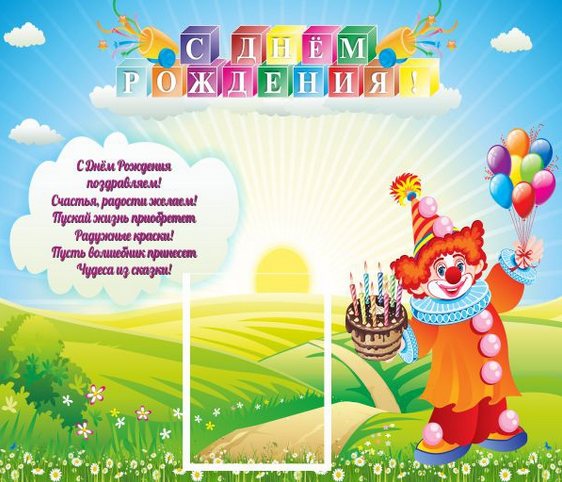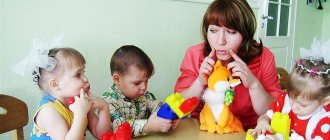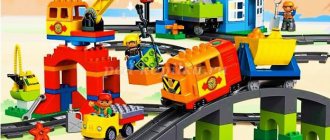Organization of a speech therapy corner in a group of combined and compensatory orientation
The effectiveness of correctional and developmental work with children with SLD largely depends on the interaction between the speech therapist and other specialists. And, above all, speech therapists and educators. In the evening, teachers consolidate the skills acquired by children on the instructions of the speech therapist. In order for correctional work to be successful, this must be done and not only the speech therapist is responsible for correctional work, the main assistants are educators and parents.
The teacher-speech therapist interacts with teachers in various forms: consultations, conversations, interaction notebook/
The teacher conducts classes in the speech therapy corner in the afternoon on the instructions of the speech therapist. Children, together with the teacher, do articulation and breathing exercises. Children practice articulation of sounds and automation in words using object pictures. Sentences and short stories are made up with these words, and games are made to differentiate the given sounds. Work is underway to expand vocabulary, grammatical structure and coherent speech. To carry out high-quality work, it is necessary that the speech corners be filled with practical material and function!
The speech corner in the group should include the following sections:
- articulatory motor skills : (mirror, card index, pictures for articulation exercises, sets of exercises for certain groups of sounds).
- automation of sounds : albums on automation of sounds V.V. Konovalenko, S.V. Konovalenko; game exercises L.A. Komarova; didactic manuals Spivak, Egorova, tongue twisters, card indexes.
- breathing : card indexes, turntables, pipes, balloons for inflation, bubbles, soap bubbles, pillows, exercise equipment for breathing development, disposable straws, games with water (grow foam, storm in a glass, boats), football with an air stream, “snake tongue” and so on.;

- phonemic hearing : musical toys, noisy boxes, card index of games.

- vocabulary : pictures reflecting the lexical topic being studied (plot and subject); educational puzzles, games: lotto, “Pick a Pair”, “Who Can Name More”, “Part and Whole”, children’s “Professions”, “all year round”, “family”, “trees”, etc.; game file.

- grammatical structure of speech : didactic manuals by N.E. Teremkova, N.S. Ruslanova, Z. Agranovich, Kosinova E.M., card index of games

- coherent speech : plot pictures, diagrams of descriptive stories, series of pictures, mnemonics, texts for retelling, Arbekova’s manuals by age


- literacy : word diagrams, sentence diagrams, a manual for sound analysis of words, traffic lights, simple puzzles, isographs, etc. manual by Z. Agranovich

- fine motor skills : small toys, tops, lacing, mosaics, puzzles, stencils for shading, internal and external tracing, pencils, etc.;

- higher mental functions : cut pictures, dominoes, “The fourth odd one”, “Color and shape”, “Recognize by contour”, etc...

I wish you success!
Zaitseva Lyubov Viktorovna teacher-speech therapist, MODU "Kindergarten No. 211", Yaroslavl
MAGAZINE Preschooler.RF
Report “Requirements for organizing a speech corner in a group of preschool educational institutions”In modern preschool education, speech is considered as one of the foundations of raising and educating children, since the level of speech determines the success of children’s education at school, the ability to communicate with people and general intellectual development. The developmental environment and communication are factors that determine speech development. Today we will look at one of the centers of the subject-development environment - the Speech Corner. It is a specially equipped space for playing alone or in small groups.
The purpose of the speech corner: to promote the creation of optimal conditions for organizing a subject-development environment in a group to improve the process of development and correction of children’s speech.
Tasks:
- Formation of phonemic perception and hearing.
- Development of articulatory motor skills.
- Strengthening the skills of correct pronunciation of sounds.
- Consolidation of skills acquired in classes.
- Activation of vocabulary, generalizing concepts and lexical and grammatical categories.
- Development of coherent speech.
- Development of fine motor skills.
Its equipment includes shelving located at different levels, a table, a chair, gaming, didactic and visual material that stimulates speech activity and verbal communication in children.
When selecting the components of a speech corner, it is necessary to take into account:
- correspond to the individual and age characteristics of children;
- the speech corner should be placed next to the book corner;
- It is important that the speech corner is comfortable and aesthetically pleasing. Beauty shapes a child. Therefore, it is necessary to pay great attention to the aesthetics of the speech corner. Its design should be attractive to children and arouse their desire for independent activity. At the same time, it is necessary to teach children to maintain order and cultivate a caring attitude towards materials and equipment contained in the corner;
- gaming material must be accessible to the child;
- An integral attribute of the speech corner should be a toy - an “animate character” , an ordinary doll, a bi-ba-bo, a puppet. Such a toy should be multifunctional. She can move (with the help of an adult or child), perform articulation exercises, ask or answer questions, ask riddles, come up with interesting stories, present unexpected surprises and much more. Her abilities will arouse keen interest in children and encourage speech activity.
- Do not overload the corner with equipment.
The speech corner is based on gaming and didactic material aimed at developing:
articulatory motor skills (object support pictures; articulatory patterns; articulatory gymnastics in albums for a specific sound; articulatory gymnastics in poetry and pictures; cotton swabs, cotton pads)
aids for the development of breathing (colorful balls; plumes; paper snowflakes; pinwheels - pencils; foil bells on a string, etc.)
aids for the development of fine motor skills (dry pool; massage rollers, balls, clothespins, stencils; finger games; various materials for composing letters)
material on onomatopoeia (noise instruments; sound boxes; children's musical instruments: piano, accordion, drums, pipe, tambourine, rattle, bells, rattles; subject, plot pictures for expressing sounds and their automation; sounds of vowels and consonants (houses for hard and soft sounds); individual manuals for sound-letter analysis; word diagrams; sound tracks, sound ladder; albums on the syllabic structure of words)
games and aids for automating sounds (small toys; object pictures; plot pictures; various types of theaters; albums for each sound; speech therapy albums for automating various sounds; tongue twisters, poems, nursery rhymes, tongue twisters; sound characteristics diagram; word diagram)
games on vocabulary and grammar (subject pictures on lexical topics)
games for the development of coherent speech (series of plot pictures; different types of theater; tongue-twisters, poems, nursery rhymes, tongue twisters; library of children's books, etc.)
literacy materials - (magnetic board; sets of magnetic letters; cash registers of letters and syllables; cubes “ABC in pictures” , “Learn to read” , “Smart cubes” , “Syllable cubes” ).
The content of the speech corner is determined not by chance, but in strict accordance with the program, physiological and psychological characteristics of the formation of children’s speech.
The selection of gaming and didactic material is carried out jointly by the speech therapist and educator, which makes their interaction not formal, but very close and fruitful.
Requirements for the content of speech centers in different age groups
Junior group
- Book corner 5-6 titles of books, 2-5 copies each, since children of this age are characterized by imitation, screen books (we select books taking into account the age of the children, namely, for this age, works of Russian folklore: ditties, nursery rhymes, songs, folk tales about animals, works of Russian and foreign classics, stories, fairy tales, poems by modern authors);
- Albums or illustrations on the topics “Toys” . “Family, “Transport” , “Pets” , “Clothing” , “Dishes” , “Furniture” .
- Pictures with simple plots and actions
- Didactic games for the formation of vocabulary, vocabulary, grammatical structure of speech, coherent speech.
- Didactic games for grouping, classification, series like “What’s extra?” , . ”
- Games like “Find a pair” , “Find the differences” .
- Game visualizers, toys - phones.
- Games with object pictures like “What has changed?”
- Pictures with a simple plot for writing stories.
- Albums of riddles, tongue twisters, songs, nursery rhymes, poems.
- Stencils, templates.
- Games for developing manual skills.
- Card index of speech games.
- Postcards about your hometown.
Middle group
- Book corner: 5-6 titles, for decoration you can use prints on the themes of Russian folk tales. Once a quarter it is necessary to organize thematic exhibitions “Fairy Tales” , “Seasons” , “Tales of Animal Friendship” , etc.
- The albums are supplemented by topics about the Russian army, the work of adults, wild animals, flowers, vegetables, fruits, and the seasons about various buildings (architecture).
- Postcards for viewing.
- Portraits of writers according to the program
- Didactic games for grouping, classification, series like “What’s extra?” , . ”
- Fable games “What in the world doesn’t happen?” , "Who's screaming?"
- Games with pictures - riddles and subject pictures like “What has changed?” "Find a match?" , "Find differences" .
- Didactic games for the formation of vocabulary, vocabulary, grammatical structure of speech, coherent speech.
- Game visualizers, phone toys, entertaining puzzles.
- Albums of riddles, tongue twisters, tongue twisters, poems.
- Stencils, templates for preparing your hand for writing
- Games to develop manual skills.
- Card index of verbal speech games.
- Postcards about your hometown, region.
- Household and antique items.
Senior group
- Book corner 7-8 books of various subjects and genres (maybe books of the same title, but illustrated by different artists). Once a quarter, thematic exhibitions with children’s drawings on a given topic are organized
- Portraits of writers according to the program
- Albums or illustrations are supplemented with information about the Motherland and technology.
- Books based on children's drawings on themes from works by children's writers.
- Portraits of artists - illustrators.
- Didactic games for the formation of vocabulary, vocabulary, grammatical structure of speech, coherent speech, in preparation for learning to read and write.
- Games - fables, games - pictures like “Name the differences” .
- Sets of pictures “Make a story from the picture” , “Put them in order and make a story” .
- ABC of letters of different textures.
- Albums of riddles, tongue twisters, tongue twisters, poems.
- Stencils, punched cards, templates for preparing your hand for writing
- Games to develop manual skills.
- Card index of verbal speech games.
- Collection of badges, stamps, calendars, labels.
- Didactic material for depicting letters (ropes, laces, wire, pebbles, sand, plasticine, etc.).
- Blanks for shading, coding, stencils, punched cards.
- Sets of letters of different colors, sizes, materials, sound rulers, syllabic rulers.
- Illustrations about monuments and museums of antiquity (Moscow, St. Petersburg).
- Map of Russia, where cities are marked with flags.
Preparatory group for school
- Availability of a library of books by section: about nature, about animals or by author. 10-12 books are exhibited, varying in genre and subject matter. Thematic exhibitions with children's drawings are organized.
- Albums or material about the work and life of writers.
- Albums of riddles, tongue twisters, poems.
- Blanks for shading, coding, stencils, punched cards for preparing the hand for writing, games for developing manual skills.
- Card index of verbal speech games.
- Collection of badges, stamps, calendars, labels.
- Didactic material for depicting letters (ropes, laces, wire, pebbles, sand, plasticine, etc.).
- Sets of letters of different colors, sizes, materials, sound rulers, alphabet letters of different textures.
- Didactic games for the formation of vocabulary, vocabulary, grammatical structure of speech, teaching children to read and write.
- Games - fables “What did the artist mix up?” , games - pictures like “Find the differences” .
- Sets of pictures “Make a story from the picture” , “Put them in order and make a story” .
- Albums or books are homemade with children’s creations and drawings.
- Corner “Read ourselves” magazines “Fidget” , “Funny Pictures” , “Sunny Bunny” , etc., children's colorful books with large print, books with educational tasks.
| Next > |
Practice using the information block for parents on lexical topics.
The problem of organizing correctional work to overcome speech impairment in preschool children (5-6 years old) with such a type of speech pathology as underdevelopment of the lexico-grammatical structure is relevant, in our opinion, because lexico-grammatical operations for generating speech are extremely complex and involve a fairly high level of development of analytical and synthetic activities.
To increase the effectiveness of correctional influence, we consider the need for integrated work in the interaction of all subjects of educational activity: speech therapists, educators, parents, physical education instructor, music director, art teacher.
An integrated approach to overcoming a speech defect involves the active participation of parents, who consolidate all the speech skills and abilities of children acquired in kindergarten in everyday life.
The purpose of the pedagogical experience: to create in kindergarten the necessary information block of complex correctional work to overcome lexical and grammatical speech disorders in preschool children (5-6 years old).
This system of work has been used in the work of speech therapists at the MADOU “Kindergarten No. 395” of the city of Perm A. F. Buzmakova, E. G. Bugrova for 15 years, has a positive expert opinion from Art. Researcher at the Laboratory of Special Education of PKIPKRO E. E. Ayupova.
“Happy Birthday!” stand: a bright design element for a children’s corner
The “Happy Birthday” children's stand is widely used to decorate a children's corner in school educational institutions, kindergartens and other specialized children's institutions.

Children's stand Happy Birthday!
What should a children's congratulations stand be like:
- wall-mounted, hanging type;
- a fairly large information field is decorated with an artistic print in bright colors;
- lightweight design does not create problems with its fastening to the wall;
- for fastening, the structure has special “ears” attached to the back of the product;
- “pocket” in A-4 format for placing both a photograph of the birthday boy and for additional wishes and congratulatory texts;
- it is possible to provide additional pockets for children’s wishes and congratulatory texts;
- It will practically fit into the interior of a school classroom, the foyer of any children's institution, as well as in a kindergarten group.
The space of the information board allows you to place several “pockets” to increase congratulations in the case where there are several birthday people.
The information equipment of the speech therapist's corner for parents includes several sections:
— expansion of vocabulary, enrichment of the active vocabulary.
For each lexical topic, an approximate vocabulary for the entire week is indicated, a circle of words is outlined that all specialists and parents, under the guidance of a speech therapist, will introduce into the active speech of children. This ensures the quickest actualization of new words for children.
— formation of lexical and grammatical means of language and development of coherent speech: lexical and grammatical games and exercises.
— development of fine and gross motor skills, coordination of speech with movement: finger and articulation gymnastics, outdoor games.
— development of phonemic, phonemic analysis and synthesis of words, phonemic representations;
— improvement of spatio-temporal orientations;
— development of constructive praxis;
- development of thinking, memory, attention.
Stand for children's drawings "Talented Artist"
The children's art stand with one pocket is designed for the winner of an art competition among kids and is well suited for kindergarten, primary school, drawing clubs and for the youngest art school students.

Children's stand "Talented Artist"
A child’s drawing that everyone will see is an additional reason to praise him and help him develop his artistic talent.
| Additional information on the topic on the website Information stands : | |
| |
Characteristics of children's speech development
In the sixth year of life, all aspects of speech are improved: vocabulary, grammatical structure, speech hearing and skills of sound analysis, coherent speech, and intonation expressiveness. The level of speech development reflects the characteristics of a preschooler’s visual-figurative thinking. The child has sufficiently developed active speech, uses detailed phrases during communication, answers questions accurately and clearly, and is able to talk about the events he witnessed. The preschooler not only identifies essential features in objects and phenomena, but also begins to establish cause-and-effect, temporal, conditional, comparative and other relationships. In this regard, speech becomes more complex structurally: the volume of statements increases, various types of complex sentences are used.In the sixth year, the child completely masters the grammatical structure of speech and uses it quite freely. The grammatical correctness of a child’s speech largely depends on how often adults pay attention to his mistakes, correct them, and show the correct example. In conversational speech, the preschooler uses both short and extended answers, in accordance with the topic of the conversation. A sufficient vocabulary allows you to participate in a conversation and maintain a conversation. Over the course of a year, the vocabulary used by a child in communication increases by 1000-1200 words compared to the previous age and reaches 4000 words. Children actively use nouns with general as well as specific meanings, recommendations from a speech therapist
Necessary:
-Learn to group objects according to characteristics , form accessible generalizing concepts.
— Improve the ability to distinguish vowel sounds by ear .
— Form correct speech diaphragmatic breathing and long oral exhalation.
— Develop the motor sphere : coordination of movements, gross and fine motor skills
— Learn to navigate in space
— Develop intonation expressiveness of speech and rhythm
Simply put:
- Read the book and discuss the content. Watching TV can generally be avoided. Cartoons 15 min. in a day. And no tablets!
- Don’t forget to play with the construction set, draw and sculpt, trace and hatch, complete the drawing.
- Listen to the sounds of the surrounding world, the sounds of speech - this is very useful and important
- Beat the rhythm with your hands, feet, sing songs.
- Learn poems, sayings, tongue twisters and tongue twisters
- Blow soap bubbles, blow out candles, etc., this will form correct speech breathing.
- Learn to classify objects (pets, dishes, etc.)
- Be emotionally open and ready to communicate.
- Folklore: “Zayushkina’s hut”, “Geese-swans”, “Three bears”, “At the command of the pike...”, “The Frog Princess”, etc.
- Fairy tales: arr. M. Gorky “The War of Mushrooms and Berries”, arr. V. Dalya “Sister Alyonushka and brother Ivanushka”, “The Fox-Shovelling”, arr. A.N. Tolstoy’s “The Zhikharka”, C. Perrault’s “Little Red Riding Hood”, the Brothers Grimm “The Town Musicians of Bremen”, etc.
- Poetry: I. Bunin “Falling Leaves”, A. Fet “Mom, look from the window”, V. Mayakovsky “Who to be?”, I. Surikov “Winter”, S. Marshak “He’s so absent-minded”, S. Mikhalkov “Uncle Styopa”, E. Uspensky “Destruction”, etc.
- Prose: N. Nosov “Live Hat”, E. Permyak “How Masha Became Big”, A. Vvedensky “About the Girl Masha...”, V. Zotov “Maple”, “Lingonberry”, K. Ushinsky “Bees on Reconnaissance”, “In the forest in summer” S. Georgiev “Grandmother’s kindergarten”
- Literary tales: A.S. Pushkin “The Tale of the Fisherman and the Fish”, V. Oseeva “The Magic Needle”, K. Chukovsky “Cockroach”, V. Bianchi “The First Hunt”, D. Samoilov “The Elephant’s Birthday”, A. Milne “Winnie the Pooh and all-all-all”, etc.
- Fables: L. Tolstoy “The Father Ordered His Sons”, “The Boy Guarded the Sheep”, “The Jackdaw Wanted to Drink”, “The Bone”.
1. The main tasks of the logopunkt:
- Correction of speech impairment
- Timely overcoming difficulties in mastering the educational program
- Clarification of specialized knowledge among teachers and parents
2. Enrollment in the logo center is carried out on the basis of the conclusion of the PMPk (psychological, medical and pedagogical council of the educational institution).
3. The examination of the speech of children of senior groups is carried out from September 1 to 15 and from May 1 to 15, children of junior and middle groups - during the school year and at the request of parents, according to the annual plan.
The maximum occupancy of a speech center for rural areas is 20 people aged 5 years and older.
The work is carried out both individually and in subgroups. There is no general group lesson.
4. Documents for the logo station:
- Consent (disagreement) to the use of technical means
- Agreement with parents
- Questionnaire for parents
Bring with you to individual lessons
- Handkerchief
- Wet wipes
- Notebook (2 pcs)
- Items for individual needs
6. Recommendations for home activities
- The duration of a lesson without a break should be no more than 15-20 minutes (you should start with 3-5 minutes).
- Classes should be held 2-3 times a day ; The best time to practice is after breakfast and after an afternoon nap.
- Designate a special place for classes where nothing can disturb the child.
- Do not use the word “wrong”, support all your child’s endeavors, praise even minor successes.
- Talk to your baby clearly, turning your face to him ; let him see and remember the movements of your lips.
- Prepare a handkerchief



